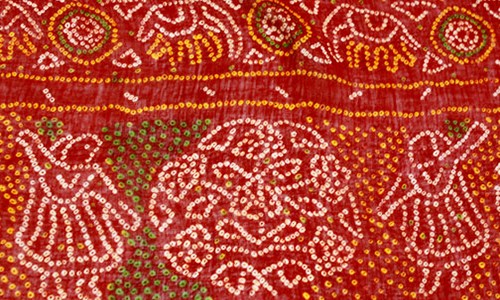- Home
- About US
- Art and Craft
- Artisans
- Master Crafts Persons
- Supporting Institutions
- News and Events
- Schemes
- Contact us
- Contact

The tie and dye textile work of Rajasthan is as popular as the state itself. The tie and dye fabrics in Rajasthan are as old as 5000 years. It is among the oldest traditions of the state that is still in practice. These Rajasthani fabrics are quite colourful and come in various colour combinations, that are hard to resist. Tourists visiting Rajasthan make it a point to buy these tie and dye fabrics, as a souvenir of their visit.
As the name suggests, the work involves tying and dyeing of fabrics. The work is available in different materials such as cotton, silk, chiffon, georgette, satin, etc. Rajasthan is famous for the fine form and abundant production of this famous technique. The tribal women in the state wear odhnis, made using this technique. The colours used in tie and dye are generally bright and contrasting.
There are various patterns of tie and dye work such as leheriya and bandhni, which are the basic ones. The 'Leheriya' tie and dye is in a wave or ripple pattern,representing waves of the sea, running diagonally on the cloth. Usually two colour patterns are used in leheriya. These colours alternate each other in the form of waves. Originally, only two colours were used for the leheriya pattern - red and yellow. Leheriya materials are available for odhnis, turbans, saris, dress materials, etc.
Another very popular pattern of tie and dye is ‘Bandhni’ or ‘Bandhej’. This is among the most preferred patterns of tie and dye. The patterns are usually floral or geometric, and the base of the fabric is mostly dark coloured like any shade of red, brown, black, green or blue.
The other patterns include ‘Mothra’, which is similar to leheriya but in a checked pattern, with opposite diagonal lines running across the cloth. The 'Shikari bandhni' includes human and animal figures depicted in vibrant colours. The 'Ekdali bandhni' has various geometric patterns in the form of small squares and circles, in various shades and clusters.
History-The tie and dye work has been in Rajasthan for several centuries. The discovery of dyes dates to ancient times, when our ancestors discovered that colours could be extracted from different parts of plants, leaves and flowers. Natural colours have been used throughout India, since historic times. The art of tie and dye was a part of trade, during the period of early trading. Some believe that the art was initially developed in Jaipur as ‘leheriya’; whereas some historians suggest that the art was brought to India by the Muslim Khatris from Sindh, who introduced it in Kutch. Even today, the Muslim Khatris are the largest community involved in the tie and dye business.
The best places to see traditional tie and dye work inRajasthan are Jodhpur and Sikar. Other places like Udaipur, Jaipur, Pali,Barmer are still in the process of reaching the same heights in tie and dye work.
Process-The process of making tie and dye work is quite simple,but also time-consuming. Over the years, the process of tie and dye has evolved and become more convenient. However, in certain parts of Rajasthan and Kutch,the traditional method is still followed. The method involves tightly tying thecloth at both ends. The area to be dyed is outlined with temporary colours. A thin sheet of plastic is then placed over the cloth. The plastic sheet has holes, and then using colours, an imprint is attained on the cloth. The craftsman thenpulls every area where the holes were placed, to tie a knot. The thread used for tying the knot is usually nylon.
After the knots are tied, the cloth is washed properly toremove any extra imprints, and then dipped in napthol for five minutes. Thecloth is again dyed in a light colour for two minutes. Next, it is rinsed and dried, and again tied and dipped in a dark colour. The cloth is kept in the dark colour for three to four hours to form the background colour of the cloth. After this, the cloth is finally washed and dried and sometimes starched for the final finishing. After the fabric dries, the folds are pulled apart in a gentle manner to get rid of the knots, and reveal the final pattern. The final result is a dark coloured cloth, with contrasting light coloured dots in different patterns.